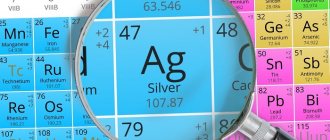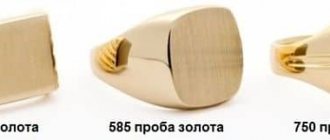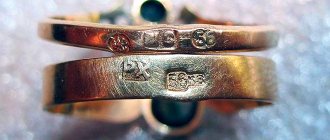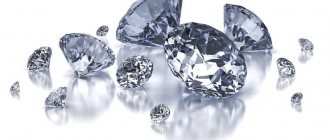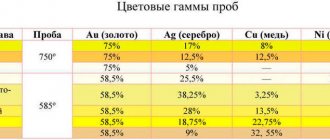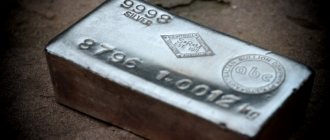Gold is a metal familiar to everyone. Jewelry made from precious metal is popular, especially among women. Gold is one of the most expensive metals in the world and is one of the top three in terms of cost per gram. You can see different numbers on the products. They mean the sample of the metal. Having certain knowledge, you can determine the density of gold.
Metal density indicator
Silver, like gold and platinum, is a currency metal. They are used to make dimensional bars, which can be purchased and sold in a bank, have their own exchange rate, and correspond to the denomination of convertible currencies. However, precious metals are often used in industry, mechanical and instrument making, medicine, and so on. For industrial needs, these alloys are also cast into ingots, only much larger than for banks. The weight of one such ingot is 20 kg.
However, due to the different densities of gold and silver, a silver bar is much smaller in size and volume. For production, compactness is a very important factor.
You can find round ingots with stamped processing. Their denomination is 5 US dollars, and they look more like regular coins. The material from which they are made has the highest purity (99.9%). Regular ingots have a purity of 99.5%.
It is this silver, purified from all possible impurities, that has the digital value of the density indicator. The indicator is indicated in all reference books, popular science literature, and school textbooks.
How to distinguish real yellow metal from a fake
Understanding the essence of density as a physical quantity will help us distinguish real gold from counterfeit gold. I'll tell you how to do this.
Au has virtually the highest density of any precious metal other than platinum, meaning that almost any gold item will weigh more than a gram.
The easiest way is to weigh the jewelry. The method is suitable for small openwork decorations.
Massive rings and chains, bracelets and earrings are checked based on the ratio of mass to volume.
We will need:
- precision scales with division values down to a hundredth of a gram;
- beaker with volume graduation. The narrower it is, the higher the accuracy of the determined value. It can be purchased at chemical stores and sometimes in pharmacies.
For clarity, I will try to determine the authenticity (maybe the purity) of my rose gold bracelet:
- I weigh the bracelet on the scales. It weighs 4.62 grams.
- I pour water into a beaker and put the bracelet in it. The water should completely cover the decoration. The bracelet displaced 0.4 centimeters of cubic water. That is, I have a beaker with a CD of 0.1 cm3, the water level has risen by 4 divisions.
- I make the calculation: 4.62/0.4=11.55.
- I compare the obtained value with the table of metal densities and the table of Au density (depending on the sample).
Palladium is close to the obtained values - 12.2, lead - 11.34, silver - 10.49. But my bracelet is a nice shade of pink, which means it most likely contains gold and copper. From the table we see that the density of my bracelet corresponds to 375 samples - the average value of gold, silver, palladium and copper.
The amount of pure element in the alloy is determined using the molar mass of gold using the formula M = m/n. The molar mass of Au is 196.9665 g/mol. In my bracelet weighing 4.62 g and 375 samples, there is 4.63 * 0.375 = 1.74 g of gold, 1.74 g / 196.9665 g / mol = 0.001 mol of pure gold.
Gemini of gold
It happens that unscrupulous jewelers, knowing that the density of the yellow metal or its alloys is close in value to base metals, use this value for criminal purposes. Thus, lead with gold plating can easily pass for 375 standard, and tungsten, which has a molar mass close to platinum group metals, is often passed off by jewelers as precious metals.
Officially accepted samples
An alloy, by definition, is the combination of pure silver with other metals for the purpose of improving some specific characteristics. There is a decree of the government of the Russian Federation, which clearly establishes silver samples, their chemical composition and characteristic properties and characteristics.
The lowest of them is 720 standard: the digital designation indicates that this alloy contains 72% pure silver, and the rest (28%) are impurities of other materials. This metal finds its use exclusively in industry and production.
The 800 standard of a silver alloy indicates that it contains at least 80% pure metal. Although it is generally considered to be of lower quality, it has good casting characteristics. It is this property that makes it possible to make sets of cutlery from this precious metal, which often become family heirlooms and are passed on from generation to generation. For the same purposes, a precious metal is used, which has 83% chemically pure silver in composition, differing from the previous one only in the smaller amount of impurities in the alloy.
But the metallic compound of silver, which has a standard 875, can already be used not only for production and industrial needs, but also in jewelry. The percentage of pure metal in it is 87.5. All of the above alloys have a pronounced yellowish color. The lower the sample, the yellower the metal. The combination of silver with metal additives of 925 standard has a white-silver (“noble”) color. This composition performs well when melted; it is very malleable and ductile. These characteristics allow jewelers to create true works of art.
960 silver alloy is very similar in its mechanical and technical characteristics to chemically pure silver. Used by jewelers to create the finest precious items, distinguished by grace and airiness: enamel and filigree, various types of engraving, combination with enamel.
It is this ease of processing that allows craftsmen to create the most magnificent and daring jewelry creations. And beautiful ladies and fashionistas can become their owners at a fairly affordable price (compared to gold and platinum items).
Description and main characteristics
The noble metal has high hardness, due to which it is widely used in jewelry and industry. Although the processing and manufacturing of the material takes a lot of time and labor, the performance qualities compensate for such problems .
Among the physical properties, it should also be noted that the specific gravity of platinum is 21.45 g per cubic centimeter, which is twice as much as that of silver. The mineral is considered one of the heaviest in the periodic table. It is second only to osmium and iridium. Metal melts at a temperature of +1769 degrees, and boils at +3800 degrees. The low thermal conductivity is explained by the high density of platinum.
The mineral is also distinguished by its plasticity. Its basic properties are not lost when thin sheets of foil and light wire are made from it. Platinum does not corrode and does not oxidize. Due to its high inertness, it does not interact with acids and alkalis. The mineral can only dissolve in aqua regia and liquid bromine, as well as when exposed to hot sulfuric acid.
How to determine a metal sample by density?
This method was invented in Ancient Greece by Archimedes. Its meaning is to weigh in water. This method also refers to non-destructive testing methods. The point is to find density; to do this, you need to weigh your product and determine its volume. Everything is clear with the first value, but how to determine the volume?
To do this, you need to measure the volume of displaced water when placing jewelry in it. Then the mass must be divided by the volume. Thus, we obtain the density value. Next, using the formula described above, we derive an expression for calculating the sample value of a specific alloy: D = 6.481-57.56/r.
Material extraction
The noble metal is rarely found in nature in its pure form. Typically, platinum contains palladium, iridium, iron and nickel. Sometimes copper, rhodium or osmium are used as impurities. Most specimens are polyxenes (ferruginous variety). No less common are intermetallic compounds: isoferroplatinum and tetraferroplatinum.
The noble mineral can be considered one of the rarest: the earth’s crust contains only 5·10−7% by mass. Known world reserves of the metal are approximately 80 thousand tons. They can mainly be found between South Africa, Russia and the USA. In our country, the main deposits of the material are located in the Krasnoyarsk Territory, the Murmansk and Sverdlovsk Regions, as well as the Khabarovsk and Kamchatka Territories. The largest nugget found in Russia is the “Ural Giant”. The mass of the material discovered at the Isovsky mine is 7860 g.
Minerals are more often found in typical igneous deposits, which are genetically related to ultramafic igneous rocks. Alloys lacking palladium are found among dunites. They are paragenetically related to chrome spinels. The palladite and nickel-palladite varieties can be found in basic igneous rocks such as norites and gabbro-norites.
Not everyone knows what platinum looks like in nature. The metal is represented by nuggets, plates, flakes or nodules. It is also mined in the form of skeletal forms and spongy secretions measuring 0.05−12 mm. Placers of the precious mineral are formed as bedrock deposits and rocks are destroyed. Grains of a flattened and lamellar appearance are found far from the primary sources.
Placer deposits are less common. They are usually explored by the method of spot testing. Platinum nuggets are mined in mines.
Since 1805, platinum has been produced in powder form from South American ore. Over time, the method of obtaining the mineral has changed:
- Platinum metal concentrate is dissolved in aqua regia.
- Ethanol and sugar syrup are then added to get rid of excess HNO3. Ammonium hexachloroplatinate is released with ammonium chloride.
- The dried sediment is calcined at +800−900 degrees.
The resulting sponge platinum is purified. It goes through all the previous processes again and is then melted into ingots.
Platinum black is obtained when solutions of metal salts are reduced by chemical and electrochemical methods.
Healing and magical properties
Platinum nanoparticles can easily penetrate into the cells of the human body and have a beneficial effect on metabolic processes occurring in the body. One of the main functions of the mineral is the destruction of free radicals and inhibition of premature aging. Some drugs used in the treatment of cancer contain platinum.
The metal has also found other uses in medicine:
- The mineral is used in the production of surgical instruments, which are sterilized in the flame of an alcohol burner. Platinum alloys containing silver, palladium, copper, zinc or nickel are excellent materials for the manufacture of dentures.
- The metal, due to its inertness to various compounds, electrical conductivity and hypoallergenicity, is actively used as a component of electrical stimulators, catheters and other types of medical equipment.
It is also worth noting the magical properties of the noble mineral. He is considered light, pure and devoid of evil. Platinum does not retain negative memories like gold. She is closely connected with the cosmos and brings wisdom and goodness to people. The material helps to illuminate the soul and enlighten the mind. Medical workers are recommended to wear a talisman made from this metal. Silver metal is also suitable for those whose activities are related to people who need help.
Platinum products are able to neutralize negative emotions and awaken positive thoughts in a person, sharpen intuition, and show their owner the right path or decision. A metal amulet will protect a person from negative influences that destroy the energy shell.
Platinum can soften the effect of precious stones. It is often used as a setting for those gems that can greatly affect their owners and cause them harm. Metal is recommended for people who want to take the path of spiritual enlightenment and turn to religious or occult teachings. When praying or meditating, it is recommended to wear a platinum ring on your index or ring finger.
The strength of the metal is also considered a magical property. Some believe that if newlyweds exchange platinum rings at a wedding, then they will be together for the rest of their lives. Durable amulets will not allow anyone or anything to separate a couple in love.
The mineral should be purchased only by calm natures prone to contemplation. Metal does not like gossipers and envious people, and it can severely punish thieves and traitors.
Platinum is associated with the planet Neptune. This metal is indicated for Pisces and Cancer. Some ancient Indian tribes worshiped platinum bars. People believed that Neptune himself heard them through the mineral.
